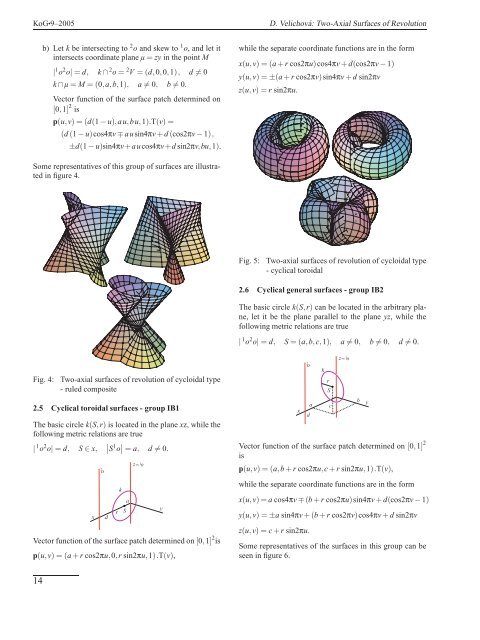Ovaj broj KoG-a u Adobe PDF formatu - hdgg
Ovaj broj KoG-a u Adobe PDF formatu - hdgg
Ovaj broj KoG-a u Adobe PDF formatu - hdgg
Create successful ePaper yourself
Turn your PDF publications into a flip-book with our unique Google optimized e-Paper software.
<strong>KoG</strong> •9–2005 D. Velichová: Two-Axial Surfaces of Revolution<br />
b) Let k be intersecting to 2 o and skew to 1 o, and let it<br />
intersects coordinate plane µ= zy in the point M<br />
| 1 o 2 o| = d, k ∩ 2 o = 2 V = (d,0,0,1), d = 0<br />
k ∩ µ= M = (0,a,b,1), a = 0, b = 0.<br />
Vector function of the surface patch determined on<br />
[0,1] 2 is<br />
p(u,v) = (d(1 − u),au,bu,1).T(v) =<br />
(d (1 − u)cos4πv ∓ ausin4πv+d (cos2πv − 1),<br />
±d(1 − u)sin4πv+aucos4πv+d sin2πv,bu,1).<br />
Some representatives of this group of surfaces are illustrated<br />
in figure 4.<br />
Fig. 4: Two-axial surfaces of revolution of cycloidal type<br />
- ruled composite<br />
2.5 Cyclical toroidal surfaces - group IB1<br />
The basic circle k(S,r) is located in the plane xz, while the<br />
following metric relations are true<br />
| 1o2 <br />
o| = d, S ∈ x, S1o = a, d = 0.<br />
x<br />
2<br />
o<br />
d<br />
k<br />
r S<br />
a<br />
z=o 1<br />
Vector function of the surface patch determined on [0,1] 2 is<br />
p(u,v) = (a+r cos2πu,0,r sin2πu,1).T(v),<br />
14<br />
y<br />
while the separate coordinate functions are in the form<br />
x(u,v) = (a+r cos2πu)cos4πv+d(cos2πv − 1)<br />
y(u,v) = ±(a+r cos2πv)sin4πv+d sin2πv<br />
z(u,v) = r sin2πu.<br />
Fig. 5: Two-axial surfaces of revolution of cycloidal type<br />
- cyclical toroidal<br />
2.6 Cyclical general surfaces - group IB2<br />
The basic circle k(S,r) can be located in the arbitrary plane,<br />
let it be the plane parallel to the plane yz, while the<br />
following metric relations are true<br />
| 1 o 2 o| = d, S = (a,b,c,1), a = 0, b = 0, d = 0.<br />
x<br />
2<br />
o<br />
d<br />
a<br />
k<br />
r<br />
S<br />
c<br />
z=o 1<br />
Vector function of the surface patch determined on [0,1] 2<br />
is<br />
p(u,v) = (a,b+r cos2πu,c+r sin2πu,1).T(v),<br />
while the separate coordinate functions are in the form<br />
x(u,v)=a cos4πv ∓(b+r cos2πu)sin4πv+d(cos2πv − 1)<br />
y(u,v) = ±a sin4πv+(b+r cos2πv)cos4πv+d sin2πv<br />
z(u,v) = c+r sin2πu.<br />
Some representatives of the surfaces in this group can be<br />
seen in figure 6.<br />
b<br />
y


